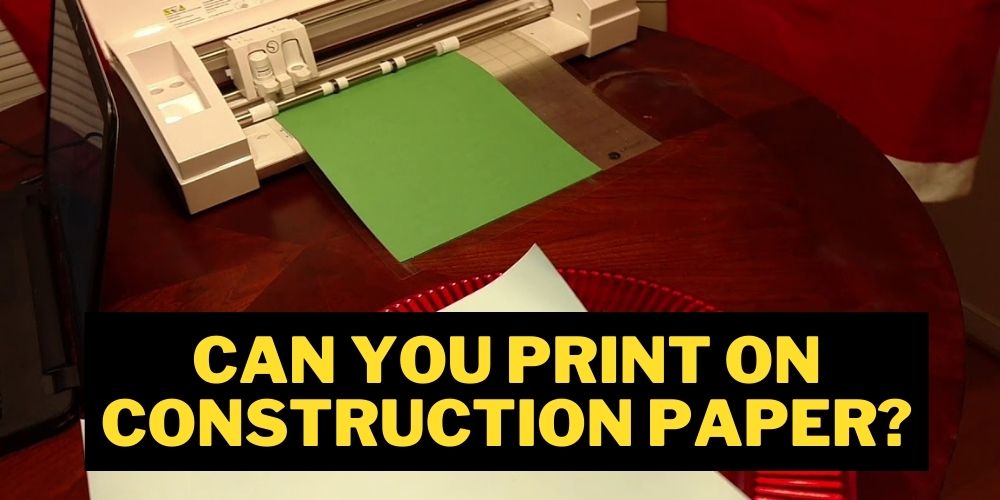A white pasty material called gesso is one of my most-needed products right now. It works as primer and makes the canvas ready for the art work.
But does gesso dry clear? That’s the confusion I had when I was experimenting with it.
Well, it will surely dry clear if you have significantly bought clear gesso. Gesso, whether white or black, dries the same hue.
There are several forms of gesso available, including transparent one. However, the colored gesso, such as white or black, does not dry transparently. Because it is particularly meant to do so, clear gesso will dry clear. You may also tint your gesso to achieve any desired hue.
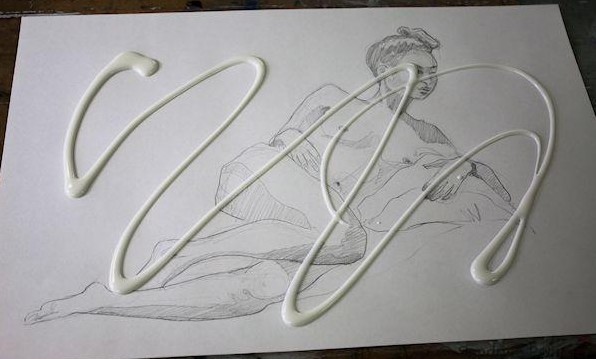
The density and texture of gesso also differs depending on the brand. After drying the gesso creates a smooth, porous, absorbent, and luminous surface on which water-based media such as tempera and casein may be applied with great precision. It also helps to make your artwork more long lasting and vibrant.
For painting on glass or windows, transparent gesso is the finest option. The way gesso dries is determined by the kind. We have experimented with several different kinds and colors of gesso to check if they dry clear or white. Let’s follow the article to have a better insight of it.
Does Gesso Dry Clear or White? The Actual Answer
Gesso is typically white, but it also comes in a variety of colors and finishes, including clear.
Is gesso transparent when it dries? The answer would be, yes it will dry clear if you buy clear gesso. Gesso, regardless of whether white or black, dries to the same color. But colored gesso will not dry clear. Because it’s not designed to do so.
For painting on glass or windows, clear gesso will be the best option.
You can mix your white gesso with your desired acrylic paint to have your preferred tinted finish.
Clear gesso, for example, dries differently than white gesso, and black gesso dries differently than both of these other forms. When purchasing gesso, it is critical to read the label to ensure that you are purchasing the correct product.
What is Clear Gesso used for?
When artists use the term “archival,” they usually imply “durable to the standards of permanent art.” “Clear Gesso” is appropriate for permanent painting by that standard. Because Clear Gesso doesn’t include as much pigment or calcium carbonate as the original formula gesso, it’s more comparable to acrylic matte paint solution.
While acrylic paints and mediums were not designed specifically to accommodate oil paint, they often perform well for this purpose, especially when oil paint is applied thinly.
Clear Gesso performs as well as white gesso of equivalent grade in terms of isolating and preserving painting supports, and it includes exquisite texture and absorbency elements.
Original, heavy-bodied white gesso, with larger quantities of pigment and calcium carbonate, is good for thicker, fatter oil paint, while Clear Gesso is fine for most purposes.
Clear Gesso has the perfect amount of grip for pastel, oil pastel, graphite, and charcoal, and it also works well as a foundation for acrylic and oil paintings.
Be it non oily porous surfaces or wooden or paper canvas. Clear Gesso is perfect for painting over any patterned or colorful surfaces. Mont Marte Premium Clear Texture Gesso is excellent when you are working with charcoal or graphite kinds of dry media.
Things to Consider Before Drying Your Gesso Clear?
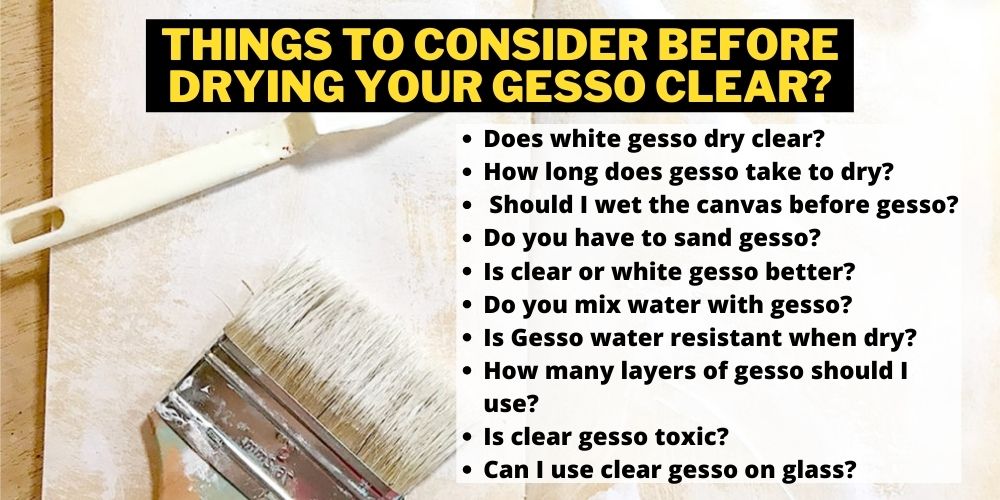
1. Does white gesso dry clear?
White gesso was typically used as a primer before applying acrylic paint to a canvas or wood surface. But it doesn’t dry clear. It could very well also be used as a matte white paint or added into acrylic paint to soften the color and remove some of the glossiness. This would be used more on wood, plastic, and even metal surfaces.
White gesso adheres to a broad range of media, including canvas, paper, and wood, and has a high bite. But it always has a whitish finish after drying. It may be colored by combining it with your favorite acrylics!
The transparency depends on how many layers of white gesso you are applying. You can also add some thinner or water with the white gesso to have a little bit of translucent finish after drying.
2. How long does gesso take to dry?
It takes at least 10 minutes for gesso to dry to the touch and a couple of hours for it to be ready to paint.
However, the actual drying time depends on a number of factors, including the ventilation in the room and the coat thickness.
It’s always preferable to follow the manufacturer’s instructions, which usually advises to wait for 10-20 minutes between applications and at least 24 hours of the full cure time of the paint. It depends on the brand.
If you can’t wait that long, you might be able to locate a gesso substitute that works better for you. When it’s dry to the touch, add a second and third layer every 10 minutes or so. Whether you’re dissatisfied with the speed at which your gesso dries or just don’t know how long to wait, you shouldn’t be in a rush. Gesso takes time to dry.
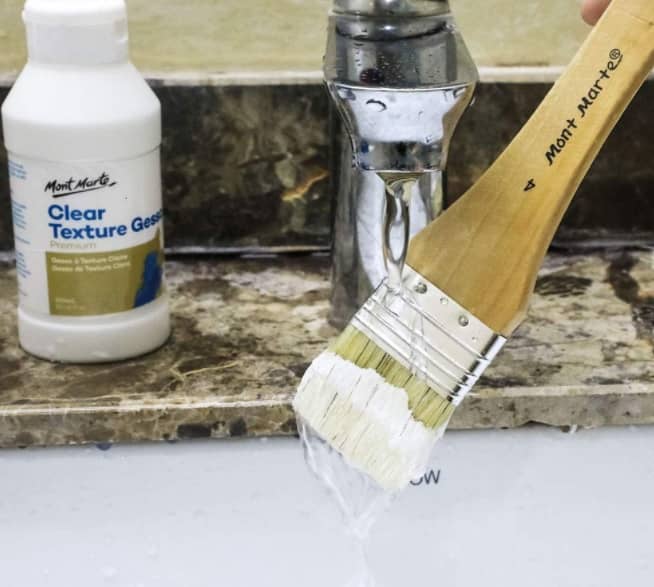
Gesso is a water-based product so the higher the temperature, the shorter the time it takes for the gesso to dry. The gesso will dry very slowly at low temperatures.
Humidity affects the rate at which gesso dries up. The air is already laden with moisture when there is high humidity. As a result, the gesso will lose water more slowly and remain wet for longer.
The length of time it takes for the gesso to dry is also determined by the wind or air current. When air flows, it reduces humidity by transporting water vapor away via circulation.
3. Should I wet the canvas before gesso?
Before you begin painting, make sure your canvas is clean and unprimed. Using a gentle, wet cloth or rubbing alcohol, wipe off your surface. Make sure your material isn’t completely wet or else it will take longer to dry. Dip your broad brush into the gesso in a basin or shallow container.
To avoid drying out the white gesso bottle, keep it closed. Apply a thin coat of gesso in a pattern that is consistent. Allow for a drying time of 20 minutes to 1 hour for the gesso.
4. Do you have to sand gesso?
The amount of times you’ll need to apply and sand gesso depends on how smooth and absorbent you want your ground to be.
If you want a particularly smooth, absorbent surface, you’ll probably just need to gesso and then sand it 2-3 times. If you want to try an experiment, you can gesso and sand your surface 4-5 times (or more!) to see if it makes a difference for you. That way, you’ll know just how many gesso layers you prefer.
Just keep in mind- Before sanding, let the gesso dry fully and after sanding, wipe away the white dust particles with a moist cloth.
5. Is clear or white gesso better?
Clear gesso lets the canvas’s natural color come through, whereas tinted gesso gives you a colored background or canvas to work with right away, which may have a dramatic influence on your work.
Compared to white gesso, clear gesso offers a number of advantages: for starters, you can put transparent gesso over the top of your sketched-out painting without tampering it in any way. Also, it lets the clean canvas’s inherent tone shine through.
6. Do you mix water with gesso?
Because most gesso is rather thick, you’ll need to thin it out with water before priming. If you don’t make the gesso thin enough, your canvas will most likely have a lot of lumpy acrylic brush strokes.
To begin, get a bowl, scoop out a dollop or two of Gesso, then pour in some water. You may or may not wish to dilute your gesso with water, depending on its viscosity . The layer will be smoother if the gesso is thinned with water.
7. Is Gesso water resistant when dry?
Gesso is a lightweight, water-resistant paint that dries quickly. Because gesso is a water-based product, it will not be completely waterproof.
Because of its water resistance, gesso will be alright if exposed to a little amount of water. Hand washing is preferable than dishwasher since you can regulate the amount of water that comes into contact with the surface.
Because gesso is a water-based product, it may readily be reactivated when exposed to water. It’s essential to apply a waterproof sealer on the glass to protect both the painting and the gesso to avoid any mistakes.
8. How many layers of gesso should I use?
Although one layer of Gesso will give adequate adherence, pinholes or unprotected areas may occur. Applying at least two layers of Gesso to any surface is suggested, especially when painting on canvas or linen. The initial layer will penetrate the support, lowering the chances of paint delamination.
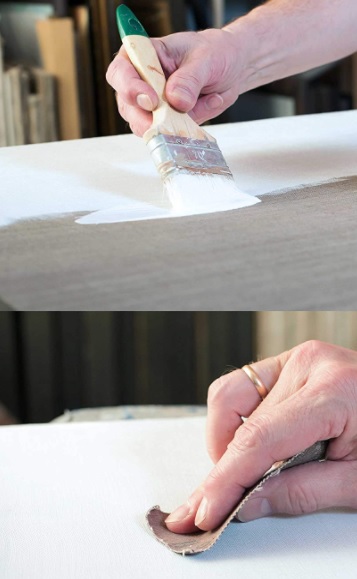
The second coat when added next to the first starts to smoothen out the surface. Gesso layers after that will provide an even smoother surface. To obtain a film equivalent to a brush application, you may need to apply more than two coats while spraying.
If multiple layers of gesso are applied, it tampers the transparency and makes the surface thicker. It is advised to apply the optimum quantity of gesso as required.
9. Is clear gesso toxic?
Up until now, there has been no substantial data available that proves that clear gesso is toxic. But after storing and using it for a long period of time your gesso might appear different and you might be wondering “does gesso go bad?”
The answer to that would be, No. Gesso is a non-perishable material.
10. Can I use clear gesso on glass?
Yes! The concern of white gesso appearing through the backside of the glass may be solved using clear gesso. A clear gesso has all of the great features of ordinary gesso but none of the color.
Adding a coat or two of transparent gesso to your project will help you achieve your artistic objectives. You may also prepare your glass surface with traditional white gesso.
Because glass is transparent, a white layer behind the paint will show through and detract from your work. You’ll get a much better outcome using a clear gesso on glass than you would with a white gesso.
How do you use clear acrylic gesso?
Purchase a tub of pre-mixed clear gesso and stir it thoroughly. Liquitex 7608 Professional Clear Gesso Surface Prep Medium and U.S. Art Supply Clear Gesso Acrylic Medium are best in the market.
The initial coat should always be diluted with a little water. Allow the first coat to dry out before applying a second coat. The second coat may be applied thinly and it does not need to be thinned out again. Add an additional layer if you want a more absorbent surface.
To achieve consistent coverage, rotate the canvas 90 degrees between applications. Apply a final coat of gesso that is pure and undiluted. Apply the gesso to the canvas in even strokes with a 3-inch decorator’s brush. Painting in parallel strokes from one edge to the other and then gradually starting working from the top down to the bottom of the canvas.
Wash your brush thoroughly under running water or with a brush cleaner as soon as possible.
Frequently Asked Questions (FAQs)
1. Can gesso be used as a sealer?
It’s important to remember that gesso is a primer, not a sealant. Because gesso, which has a satin or matte texture when applied, is absorbent, it will not fully seal the wood until numerous coats are done, and even then, it may not seal.
2. What can I use instead of clear gesso?
Commercial acrylic primers, rabbit skin glue, and oil painting grounds are the finest clear gesso alternatives. You may also make your own gesso for acrylic or oil painting at home by mixing 1/4th cup of talcum powder with 1Tb spoon of PVA glue and 1tb spoon of white acrylic paint.
3. Does Golden make a clear gesso?
Golden gesso can be used as transparent gesso to show off the texture and appearance of the canvas or other support. A clear and matte finish would be achieved with golden gesso. Two coats of application are suggested as a minimum requirement while using golden gesso.
Final Thought
Traditional gesso which are generally white in color does not dry clear. It has a milky white tint after drying on canvas. But to make it clear, mixing it with any kind of thinner or a little bit of water is recommended.
Sometimes the transparency depends on how thick you apply the paint, and the types of brand. Gesso is also available in a variety of different colors and finishes including clear gesso. But colored gessos whether black and white are not meant to dry clear.
So if you want your gesso to have a transparent finish, transparent gesso will be perfect for you.

